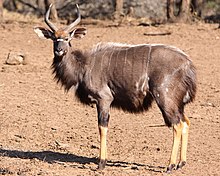| Nyala | |
|---|---|

| |
| Male | |

| |
| Female | |
| Scientific classification | |
| Domain: | Eukaryota |
| Kingdom: | Animalia |
| Phylum: | Chordata |
| Class: | Mammalia |
| Order: | Artiodactyla |
| Family: | Bovidae |
| Subfamily: | Bovinae |
| Genus: | Tragelaphus |
| Species: | T. angasii
|
| Binomial name | |
| Tragelaphus angasii (Angas, 1849)
| |

| |
| Geographic range | |
| Synonyms[2] | |
| |
The lowland nyala or simply nyala (Tragelaphus angasii)[3] is a spiral-horned artiodactyl antelope native to Southern Africa. The species is part of the family Bovidae and the genus Tragelaphus (formerly placed in the genus Nyala). It was first described in 1849 by George French Angas and exhibits the highest sexual dimorphism among the spiral-horned antelopes. It is not to be confused with the endangered mountain nyala living in the Bale region of Ethiopia.
The nyala's range encompasses much of Southern Africa. As its population is relatively stable, it has been listed as of least concern by the International Union for Conservation of Nature. It generally browses during the day in warm weather and during the night in the rainy season. As a herbivore, the nyala feeds upon foliage, fruits and grasses, and requires sufficient fresh water. A shy animal, it prefers water holes rather than open spaces. The nyala does not show signs of territoriality, and individuals' areas can overlap. They are very cautious creatures.
They live in single-sex or mixed family groups of up to ten individuals, but old males live alone. They inhabit thickets within dense and dry savanna woodlands. The principal threats to the species are illegal poaching and habitat loss resulting from human settlement and livestock grazing. However, the large-horned, impressive males are highly prized as game animals by sport hunters.
- ^ IUCN SSC Antelope Specialist Group. 2016. Tragelaphus angasii (errata version published in 2017). The IUCN Red List of Threatened Species 2016: e.T22052A115165681. https://dx.doi.org/10.2305/IUCN.UK.2016-3.RLTS.T22052A50196443.en. Accessed on 01 May 2022.
- ^ Cite error: The named reference
huffmanwas invoked but never defined (see the help page). - ^ Cite error: The named reference
burtonwas invoked but never defined (see the help page).
